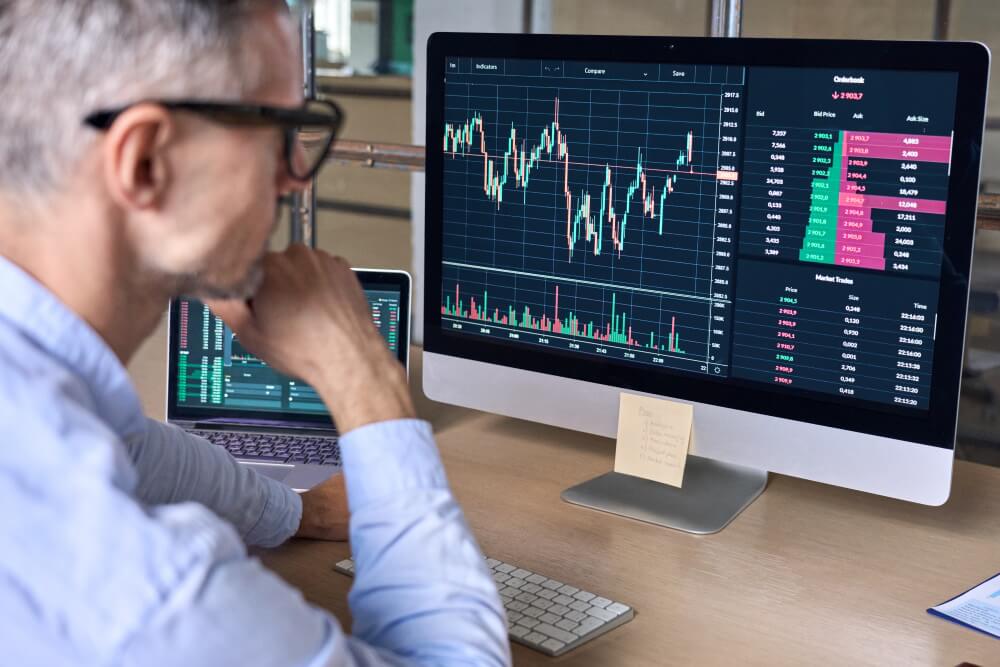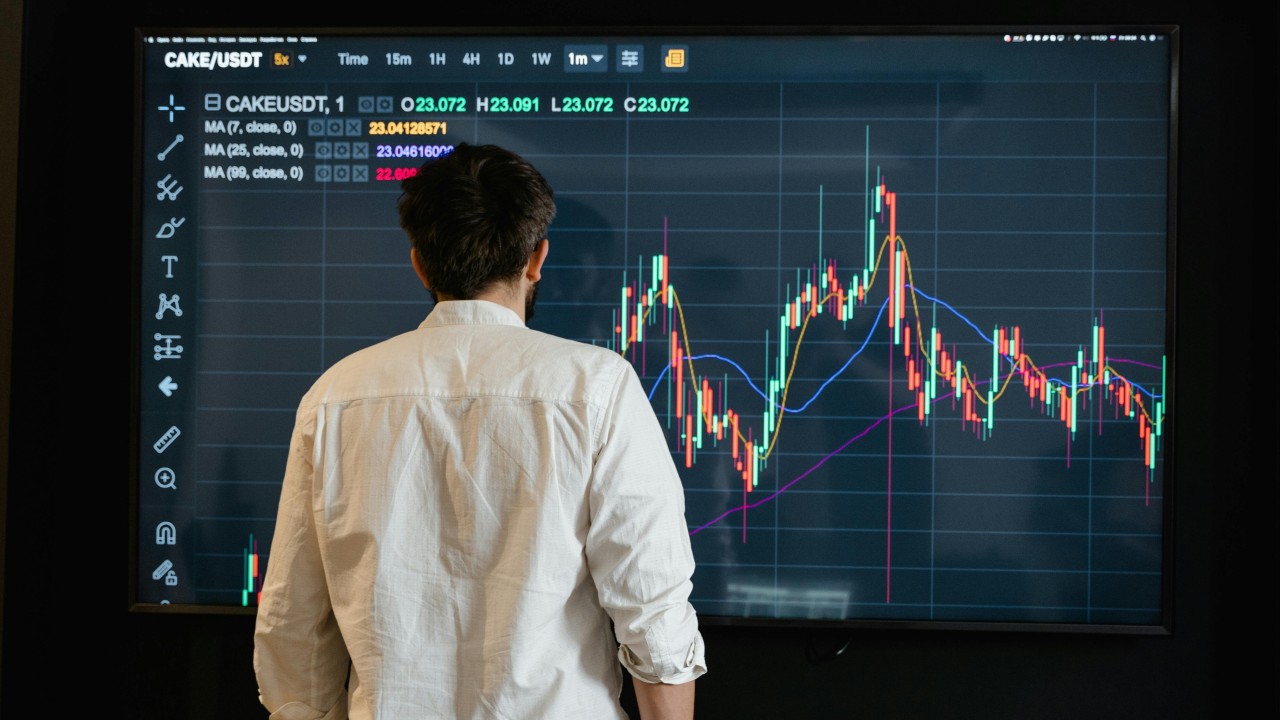When people ask Is Forex Trading Hard they picture endless charts, tight leverage, and a maze of account rules that can trip up beginners. Choosing between a demo account, micro or cent account, mini or standard account, ECN or STP execution, or a managed and PAMM account can change how fast you learn and how much risk you take.
This guide explains spreads, commissions, margin, order types, platforms, and account size, allowing you to compare demo, funded, and retail options and select the account that best suits your trading style. Ready to find the account that matches your goals and risk tolerance?
If so, Goat Funded Trader's prop firm offers funded account paths and clear evaluation steps that let you test strategies on demo and funded accounts, compare execution and scaling, and build confidence before you commit your own capital.
What is a Forex Account?

What a Forex Account Means — Your Access Point to Currency Trading
A forex account is the trading account you open with a broker to buy and sell currency pairs. You log in to an online trading platform, place orders to buy one currency and sell another, and the broker executes those orders on global liquidity providers. The money you deposit becomes the margin that lets you open positions and measure profit and loss in pips and lots.
How Leverage and Margin Work in Your Account
Leverage multiplies your market exposure relative to the funds in your account. With 50 to 1 leverage, a 1000 account can control a 50,000 position size, but that same leverage increases the chance of margin calls and stop-outs when the market moves against you. Margin requirement shows how much capital you must set aside to hold a position, while free margin shows what remains available to open new trades. Watch the lot size and pip value, as these determine how a price move affects your equity.
Execution Types and Trading Platforms You Use
Most brokers offer MetaTrader 4, MetaTrader 5, or cTrader as trading platforms, and each supports market execution and instant execution order models. Market execution matches orders at the best available price, but can result in slippage in fast-moving markets. Instant execution attempts to fill orders at your requested price; if not, it rejects and requotes. Order types include market orders, limit orders, stop orders, and trailing stop orders that automate entries and exits.
Costs Built Into a Forex Account
Trading costs are typically represented as spreads, commissions, or a combination of both. A spread-only account includes the broker fee in the difference between bid and ask, while ECN accounts often charge a raw spread plus a separate commission per lot. Overnight positions may incur swap charges unless you hold a swap-free account. Also, be aware of deposit and withdrawal fees, conversion charges tied to your account's base currency, and any inactivity fees that some brokers may impose.
Demo Versus Live Accounts and the Psychology Shift
A demo account simulates prices and allows you to test strategies without risking capital. Still, it cannot replicate the emotional pressure of real losses or the slippage you will encounter in live markets. Many traders use demo accounts to learn about platforms, test execution, and refine their risk management strategies before they can apply these skills with real money. When you switch to a live account, your discipline and position sizing become the core variables that determine results.
Funding, Account Base Currency, and Settlement Details
You can fund an account using bank wire, credit card, e-wallet, or cryptocurrency, depending on the broker's options. Choose an account base currency that matches your native currency to reduce conversion fees when you deposit or withdraw. Brokers show balances, open P and L, and margin in your account currency, and settlements reflect conversion rates when you close trades in pairs that do not include your base currency.
Regulation, Security, and Account Protections to Check
Verify a broker's regulator, client fund segregation, negative balance protection, and insurance arrangements before you open an account. KYC procedures will require ID and proof of address to comply with anti-money laundering rules. Institutional accounts and professional accounts can carry different leverage limits and protections than retail accounts, so confirm the legal status you want to trade under.
Managed Accounts, Copy Trading, and Professional Services
If you prefer not to trade yourself, you can use PAMM, MAM, or copy trading services where a manager or system executes trades on your behalf. These services charge performance fees and management fees and require trust in the manager's track record and risk controls. Ask about trade transparency, drawdown limits, and fee structures before allocating capital.
Forex Trading Account Types

1. Standard Account — The Workhorse for Traders Who Want Balance
A standard account is suitable for traders who have progressed beyond the basics and want reliable trade sizes, access to advanced platforms, and steady execution. Trades use standard lots of 100,000 units of the base currency. Spreads typically range from 1 to 3 pips, depending on the broker and market volatility.
Brokers often incorporate charges into the spread rather than levying separate commissions, although some will charge a small per-trade fee. Execution tends to be fast and stable, supporting scalping, day trading, and swing trades. Minimum deposits typically range from $100 to $500, and available leverage and margin rules vary depending on the broker and the applicable regulator.
What you gain and what you lose with a standard account
Advantages include balanced trading costs and profit potential, access to professional charting and analysis tools, and flexibility across strategies. Disadvantages include a higher minimum deposit compared to micro options, wider spreads than some direct-access accounts, and exposure to spread expansion during major economic events and periods of low liquidity. How sensitive are you to spread and execution when you place a trade?
Who benefits from a standard account?
This account is suitable for traders with some experience, sufficient capital to handle standard lot exposure, and a preference for paying via spreads rather than regular commissions. If you trade in petite sizes or want the lowest possible spreads for high-volume trading, you may wish to compare micro or ECN options first.
2. Micro Account — Low Entry Cost, Small Lots, Lower Risk Exposure
A micro account targets beginners and traders who test strategies live with minimal capital at risk. A micro lot equals 1,000 units of the base currency, or 0.01 of a standard lot. Spreads tend to be wider because brokers offset low volume and smaller trade sizes. Fees are typically included in spreads, and execution can slow down during periods of high market activity. Minimum deposits can range from $10 to $100, depending on the broker.
What you gain and what you lose with a micro account
Advantages include low capital barriers, the ability to practice real order placement, and access to broker educational tools. Disadvantages include higher relative trading costs per pip, slower fills that can hinder timing-sensitive moves, and limited profit potential due to small position sizes. Would you rather preserve capital while you learn or push for bigger gains from the start?
Who should open a micro account?
Choose a micro account if you want to manage risk tightly while learning pips, margin, and leverage in a live market. Traders looking to scale quickly, scalp for very tight spreads, or institutional traders should consider standard or ECN configurations instead.
3. ECN Account — Direct Market Access for Speed and Transparency
An ECN account connects you to banks, hedge funds, and liquidity providers, showing market-driven bid-ask pricing and tight spreads that can be near zero in calm markets. Trade size can match standard lot conventions, and the broker typically charges a fixed commission per trade to cover execution and routing. Execution is swift, which suits scalping and high-frequency trading strategies, as well as traders who require minimal slippage. Minimum deposits usually start at $500 or higher.
What you gain and what you lose with an ECN account
The advantages include transparent pricing, very low spreads under normal conditions, and near-instant fills with direct market access. Disadvantages include commission costs that add up with high trade frequency, higher initial deposit requirements, and complexity that can overwhelm beginners. Spreads may widen during major news and periods of thin liquidity. Do you have the discipline and strategy sophistication to trade with direct market access?
Who benefits from an ECN account?
This account type is best suited for experienced traders, high-volume traders, and institutions that value the tightest spreads and fastest execution. If you practice scalping or run algorithmic strategies, ECN often provides the raw pricing and execution you need.
4. Islamic Account — Swap Free Trading that Aligns with Faith Rules
An Islamic account removes overnight interest or swap charges to comply with Sharia finance rules. Trading conditions otherwise mirror the base account type the broker offers, whether standard or ECN. Brokers replace swap income with alternative mechanisms, such as slightly wider spreads or fixed fees per trade, to cover overnight financing costs. Availability and exact terms depend on the broker and may require verification.
What you gain and what you lose with an Islamic account
There are no swap charges on overnight positions, making these accounts worthwhile for positions held over multiple days. Brokers sometimes broaden spreads or impose conversion fees to compensate. Not all brokers offer swap-free accounts, and some require additional paperwork to qualify. Are you reviewing the fine print on spread changes and fixed fees before applying?
Who should use an Islamic account?
This option suits traders who must avoid interest for religious reasons and still want access to the forex markets. Confirm how your broker offsets swap removal and run a few test trades to see the real cost per pip before committing significant capital.
Related Reading
- What Is A Lot Size In Forex
- How Much Do You Need To Start Trading Forex
- How Profitable Is Forex Trading
- What Is Swap In Forex Trading
- How To Learn Forex Trading
- Automated Forex Trading
- Fibonacci Forex Trading
- Pros And Cons Of Forex Trading
- Forex Trading Profit Per Day
Zero vs. Prime Accounts in Forex

Zero Account
A Zero account gives you extremely tight quoted spreads, often showing 0.0 or 0.1 pips on major pairs. Brokers offset that pricing by charging a fixed commission per lot. That makes the visible spread small while trading costs become the sum of commission plus any slippage or overnight financing. Execution typically occurs through ECN or STP routing to liquidity providers, allowing orders to match with other participants rather than being held by a dealing desk. Which trading platform matters too; many zero accounts support MetaTrader, cTrader, or a FIX API for algorithmic traders.
The amount you pay depends on the number of standard lots you trade and the commission schedule. High-frequency scalpers appreciate the predictable micro costs of a zero structure, as they can calculate the expense per trade precisely and optimize edge and position sizing while adhering to margin and leverage rules.
Prime Account
A Prime account blends low spreads with deeper institutional liquidity and priority execution. Brokers offering prime terms often utilize a liquidity aggregator or prime brokerage model, which connects you to multiple banks and market makers. Spreads are generally low, although not consistently as low as the best zero quotes. Brokers may reduce or waive explicit commission fees for clients who meet specific threshold requirements or maintain substantial balances. Firms that need direct market access, DMA, or custom margin conditions often choose prime accounts.
Prime accounts also often include premium services, such as account managers, tailored reporting, custom risk settings, and access to higher leverage tiers or separate liquidity pools. Those perks are beneficial when trading large sizes or requiring better price depth and lower slippage on block orders.
Spread Differences
Zero Accounts are characterized by near-zero spreads, meaning the difference between the bid and ask price is minimal or almost nonexistent. This creates a highly cost-efficient trading environment for traders focused on tight pricing. On the other hand, Prime Accounts offer low spreads, which are usually slightly higher than those found in Zero Accounts but remain competitive to support significant trading volumes.
Commission Structures
A defining feature of the Zero Account is the fixed commission charged per trade. This commission compensates for the very low spreads and makes trading costs transparent for traders. Conversely, the Prime Account typically offers either low commission fees or, in some cases, no commission at all, making it an attractive option for traders who prefer fewer explicit trading fees.
Order Execution Speed
Both account types provide fast order executions, but Zero Accounts typically ensure speedy, smooth order processing without requotes, which is crucial for scalping strategies. Prime Accounts also offer fast execution speeds with professional-grade trading conditions, supporting high-frequency and large-volume trades efficiently.
Minimum Deposit Requirements
Zero Accounts usually require a medium to high minimum deposit, ranging approximately from $100 to $500. Prime Accounts require a higher initial deposit, typically starting at around $500 or more, reflecting the account’s premium features and target clientele.
Ideal Trader Profiles
Zero Accounts are best suited for scalpers and day traders who trade frequently and rely on minimal spreads, combined with transparent commission costs, to optimize profits. Prime Accounts cater more to professional traders or those executing high-volume trades who may benefit from fewer commissions and tailored trading conditions.
Availability Among Brokers
Zero Accounts are widely available across many brokers, given their popularity among active traders. In contrast, Prime Accounts tend to be less common and may be restricted to VIP clients or those with substantial deposits, offering enhanced services and exclusivity.
Practical Checklist: How to Choose Between Zero and Prime
- Calculate your total round turn cost: spread pips times pip value plus commission per lot.
- Estimate monthly traded volume and average lot size to see where per lot commissions pay off.
- Test execution on a demo under live feed hours and measure slippage, requotes, and latency.
- Check platform support: MetaTrader, cTrader, FIX API, DMA.
- Verify margin, leverage, and negative balance protection.
- Review swap rates, rollover rules, and any account maintenance fees.
- Ask about liquidity providers, prime brokerage links, and whether the broker hedges client flow.
What is your typical trade size and frequency? Use that to run the numbers and decide which account reduces friction for your strategy.
How to Choose the Right Forex Account Type for You

Micro Accounts for New Traders
Do you have limited capital and want to trade with real money while keeping risk small? Micro accounts allow you to buy and sell currency in micro lots, typically 1,000 units of the base currency. That reduces the pip value and limits dollar exposure on each trade. Brokers often advertise low minimum deposits and stringent account requirements, so be sure to verify the actual minimum deposit, the spread type, and whether they permit scalping or automated trading strategies. Use a demo account first to verify order execution, slippage, and platform reliability before moving to a live micro account.
Standard Accounts for Steady Progress
Are you past the absolute beginner stage and ready to scale position size and strategy complexity? Standard accounts trade around 100,000 unit lots, but leverage and margin let you open smaller effective positions. These accounts often feature modest spreads without additional commissions, making them suitable for swing traders and day traders who seek balanced trading costs and potential returns. Watch leverage limits, margin call levels, and overnight financing rates, as these factors affect risk and position sizing. Additionally, select a broker with transparent pricing, stable execution, and practical risk management tools, such as guaranteed stop-loss orders when available.
ECN Accounts for Active Professionals
Do you require the tightest spreads and the fastest fills for high-volume or algorithmic trading? ECN accounts route orders to liquidity providers and display raw spreads that are close to zero. In return, brokers charge a commission per lot, and initial deposit requirements can be higher. ECN suits scalpers, high-frequency traders, and anyone who needs minimal slippage and minimal spread markup. Confirm the commission structure, latency, and whether the broker offers a virtual private server for automated systems. Also, verify how they handle liquidity gaps, requotes, and partial fills during volatile sessions.
Islamic Accounts with No Overnight Swap
Do you require a swap-free account for religious reasons? Islamic accounts remove overnight swap charges to avoid interest-based financing. Brokers may offer these accounts in either standard or ECN style, but some replace swaps with administrative or service fees, so it is essential to read the fee schedule carefully. Check which currency pairs and instruments qualify for swap-free treatment and whether long-term positions carry additional charges. Ask for a written policy on swap-free accounts and proof of compliance if that matters to you.
Quick Checklist to Match Account Type to Your Profile
Which matters most to you, low entry cost, predictable spreads, lowest trading cost per lot, or religious compliance? Look at minimum deposit, spread type, commission per lot, leverage and margin rules, allowed trading strategies, swap-free options, and broker regulation: test execution and slippage on a demo account. Compare real trading costs by calculating the spread plus commission per typical trade size to see which account suits your trading tactics, whether you're scalping, day trading, swing trading, or using automated trading.
Related Reading
- Forex Trading Candlestick Patterns
- Forex Trading Algorithms
- Risk Management In Forex Trading
- Forex Trading Day
- Minor Forex Pairs
- Forex Trading Vs Crypto Trading
- Advanced Forex Trading
- Copy Forex Trading
- Best Books On Forex Trading
- Best EA For Forex Trading
Factors Influencing Account Type Selection

Risk Tolerance
Your risk tolerance decides the account class you should pick. Standard accounts allow you to trade full lot sizes with higher leverage, which increases profit potential but also raises margin requirements and the risk of a margin call during a drawdown. Micro and mini accounts reduce position sizing, allowing you to risk a fixed percentage of your account balance on each trade and keep drawdowns smaller. This helps when you are still building muscle memory for stop-loss discipline and effective position sizing. How do you react to a losing trade? Do you stay calm or chase a recovery? Try fixed risk per-trade rules on a demo account and then on a micro live account to see which risk profile suits your psychology and capital.
Trading Strategy
Scalpers and high-frequency day traders require accounts with tight spreads, low slippage, fast execution, and support for small lot increments, allowing them to enter and exit quickly without incurring significant holding costs. ECN and raw spread accounts often suit this style because they offer better pricing and lower spreads in exchange for a commission per trade.
Swing and position traders should consider swap rates and overnight fees, as holding costs can add up; a standard account with competitive spreads and reasonable swap rates can help lower the cost of multi-day or multi-week trades. Which trading style do you use more often: short, quick trades or positions that last days or weeks? Match the leverage, lot size increments, and execution type to your chosen strategy so that your account supports the mechanics of your system.
Trading Capital
If you start with a small deposit, micro and mini accounts allow you to scale your position size without exposing the account to large percentage swings, keeping margin usage low and avoiding early margin calls. Larger balances can sustain standard accounts where you can size positions for meaningful returns while absorbing losing streaks, and you can use higher leverage more cautiously.
Apply position sizing rules, such as risking one to two percent of equity per trade, and check required margin and margin level frequently. Factor in slippage and commissions when planning trade size. Will your account survive a string of losses long enough to let your edge work? Test that with realistic back testing and forward testing on a funded or demo account.
As a prop firm, Goat Funded Trader gives you access to simulated accounts up to $800K with trader-friendly conditions, no minimum targets, no time limits, triple paydays, up to 100% profit split, and a 2-day payment guarantee with a $500 penalty for delays. Choose from customizable challenges or instant funding and sign up to access up to $800K today, with 25-30% off.
How to Open a Forex Account?

Pick a Broker That Fits Your Trading Plan
Research brokers for regulation, trading platform options, fees, and account types. Which regulator matters to you, FCA, ASIC, CySEC, or an equivalent? Do you need segregated accounts, negative balance protection, or local bank payment options? Compare execution types, such as ECN or STP, and verify whether brokers offer standard, mini, micro, or professional accounts.
Look for demo accounts, managed account options such as PAMM or MAM, and Islamic swap-free accounts if you need them. Inspect spreads, commission models, minimum deposit, available leverage, margin requirements, and order execution speed. Test customer support and read reviews about deposit and withdrawal speed to see how the broker handles real client issues.
Get Your Paperwork Ready
Gather a clear government ID, such as a passport or driver's license, and recent proof of address, like a utility bill or bank statement. Brokers typically request the following information: full name, email, address, phone number, date of birth, employment status, annual income, estimated net worth, and trading experience.
Choose your base currency early, since the account base currency affects conversion fees and margin calculations. Create a strong password and prepare for two-factor authentication, if offered by the broker. For larger accounts, expect requests for proof of source of funds or bank statements.
Fill the Account Application
Complete the online application carefully and honestly. Select the account type that matches your strategy and risk tolerance, whether a standard account with fixed or variable spreads, an ECN account with raw spreads and commission, or a micro account for small lot sizes.
Choose the execution type, leverage cap, and platform at this stage. Answer questions about trading experience and objectives accurately to avoid later reclassification from retail to professional or vice versa. Keep a copy of the submitted form and note any reference or account numbers for follow-up.
Verify Your ID and Pass KYC
Upload high-quality scans or photos of your ID and proof of address so the text and details are legible. Match the name and address exactly to what you entered on the application to reduce verification delays.
Expect anti-money laundering checks and occasional enhanced due diligence if you deposit large sums or originate funds from unusual jurisdictions. Verification times vary from minutes to several business days, depending on the broker and the complexity of your documents.
Fund Your Account
Deposit via the method that balances speed, cost, and safety. Options typically include bank transfer, credit or debit card, and e-wallets; some brokers accept cryptocurrency. Watch for minimum deposit requirements, deposit fees, and currency conversion charges when your bank currency differs from the account base currency.
If you need algorithmic trading or expert advisors, check whether the broker supports virtual private server services and allows automatic trading. Which payment path gives you the best combination of low fees and fast credit on the platform?
Log In, Set Up, and Start Trading
Download or access the trading platform, such as MetaTrader 4, MetaTrader 5, or cTrader, and log in with your account credentials. Try a demo account to practice order types, market, limit, stop, and trailing stop, and to see true to market spreads under live conditions: Configure lot sizes, leverage limits, margin checks, and alerts for margin calls and stop-out levels.
If you choose an ECN account, expect raw spreads plus commission; STP accounts usually fold the cost into wider spreads. Set up two-factor access, customize charts, and review the trade execution policy and slippage reporting before placing live trades.
Get 25-30% off Today - Sign up to Get Access to Up to $800K Today

Goat Funded Trader offers traders access to simulated accounts of up to $ 800,000, featuring trader-friendly conditions that minimize the friction between skill and capital. You can choose from customizable challenges or start with instant funded accounts, and the offer includes a profit split of up to 100% and triple payout events. Over 98,000 traders have collected more than $9.1 million in rewards, with payouts typically cleared within two business days. However, if Goat Funded Trader experiences delays, the trader is required to pay a $500 penalty. Want to try a larger account without the ordinary red tape?
Account Types You Can Access Right Now
Which account type fits your trading style: an evaluation challenge, an instant funded account, or a simulated demo that mirrors real size and leverage? Goat Funded Trader offers simulated accounts that behave like live funded accounts, so you can test order types, market execution, stop loss and take profit rules, and spread behavior before you trade live capital. These options correspond to common forex trading account types, including demo accounts, evaluation accounts, instant-funded accounts, and fully funded live accounts.
How Funded Accounts Differ from Standard Retail and Institutional Accounts
Funded accounts through a prop firm differ from standard retail ECN or STP accounts, as well as from institutional accounts, in several ways. You trade company capital under defined risk rules and drawdown limits instead of using only your account balance. Leverage, commission, and spread details aim to match retail ECN or STP conditions while incorporating a profit-sharing structure. Managed accounts, such as PAMM or MAM, differ in that an account manager executes trades on behalf of investors, whereas a funded trader executes their own trades using company capital. Which model suits your edge and discipline?
Why the Rules Matter for Traders
Risk rules shape how you size lots, set leverage, and manage margin and free equity. Goat Funded Trader removes minimum profit targets and time limits, letting you focus on consistent risk management rather than racing to hit an arbitrary number. That matters when you prefer scalping, day trading, swing trading, or holding positions through news, where margin and overnight swap costs affect outcomes. How would trading change if you only had to follow steady risk rules?
Evaluation Versus Instant Funding Explained
Evaluation accounts or challenge accounts are performance-based assessments that require traders to meet rules for profit, drawdown, and risk management before receiving a funded account. Instantly funded accounts bypass the multi-step evaluation process and grant immediate access to company capital, often with similar risk limits. Goat Funded Trader offers both paths, allowing you to choose the one that aligns with your confidence, track record, and need for speed. Do you want to prove a track record first or start trading capital right away?
How Common Forex Account Types Compare
Demo account
Simulated balance, zero real risk, ideal for testing platforms like MT4, MT5, or cTrader, and practicing order types and slippage.
Simulated funded account
Mirrors fund account rules and sizes, applicable for practicing drawdown limits and position sizing.
Evaluation challenge
Formal assessment with profit targets, drawdown caps, and a fee to enter.
Instant funded account: immediate access to firm capital, profit splits, and honest payouts.
Live retail account ECN or STP.
You trade your own capital, subject to market spreads, possible commissions, and broker margin rules.
Standard, mini, and micro accounts
Differ by lot size and minimum deposit, which helps build position sizing skills.
Managed accounts, PAMM, MAM
Investor funds are managed by a trader or manager rather than the trader trading directly on a funded account.
Swap free accounts
Avoid overnight swap charges for legislative or personal reasons. Which account gives you the right combination of spreads, leverage, and execution?
Payouts, Profit Share, and Fee Structure
Goat Funded Trader pays up to 100 percent profit split and offers triple payout events to accelerate returns to traders. Entry and evaluation fees vary depending on challenge size and customization. Payout timing matters: the two-day payment guarantee reduces cash flow uncertainty and includes a five-hundred-dollar penalty for missed deadlines. Sign up now to access up to $800K and get 25 to 30 percent off if you act on the current offer.
Trading Tools, Execution, and Rules You Should Check
Before you trade, verify platform compatibility with MT4, MT5, or cTrader, confirm order execution type, inspect typical spreads and commissions, and learn the firm’s rules on margin calls, forced liquidation, and allowed instrument types, including major and minor forex pairs. Check whether news trading, high-frequency strategies, and hedging are allowed and how slippage is treated during volatile events. What trading edge will you use under these conditions?
Who Benefits Most from This Funding Model
Traders who possess a repeatable edge, disciplined position sizing, and precise risk control tend to benefit most from funded account models. If you trade micro lots to manage psychology, prefer ECN-like spreads, or want to scale from mini to standard lot sizes under someone else’s capital, funded programs can accelerate growth without increasing personal capital at risk. Which part of your process requires the most capital?
Related Reading
- Forex Options Trading Strategy
- Best Laptop For Trading Forex
- Forex Trading Course For Beginners
- Forex Trading App For Beginners
- How To Choose The Best Forex Broker
- Best Forex Pairs To Trade During New York Session
- Forex Trading Strategies For Beginners
- Forex Algorithmic Trading Strategies
- Best Forex Pairs For Beginners
.svg)
.avif)



.avif)





.svg)

.svg)